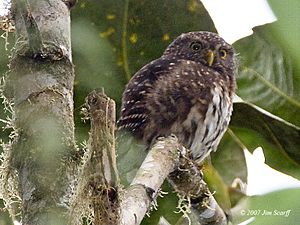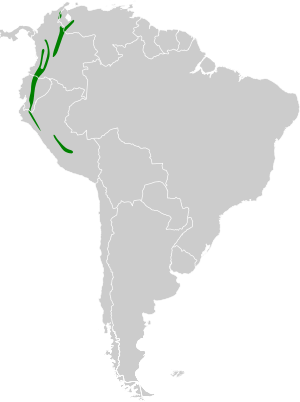Andean pygmy owl facts for kids
Quick facts for kids Andean pygmy owl |
|
|---|---|
 |
|
| Upper Tandayapa Valley, NW Ecuador | |
| Conservation status | |
| Scientific classification | |
| Genus: |
Glaucidium
|
| Species: |
jardinii
|
 |
|
| Distribution of Andean pygmy owl Resident | |
The Andean pygmy owl (Glaucidium jardinii) is a small type of owl. It belongs to the owl family called Strigidae. You can find this owl in several South American countries. These include Colombia, Ecuador, Peru, and Venezuela.
Contents
What Does the Andean Pygmy Owl Look Like?
The Andean pygmy owl is a small bird. It is about 15 to 16 cm (5.9 to 6.3 in) long. That's about the size of a small ruler! Male owls usually weigh between 54.9 to 77.4 g (1.9 to 2.7 oz). Female owls are similar, weighing about 54.6 to 75 g (1.9 to 2.6 oz).
These owls come in two main colors. Some are dull dark brown, while others are dark chestnut. Both types have white or buff markings on their bodies. Their heads have small white dots. They have bright yellow eyes with white "eyebrows" above them. They also have white "mustaches" and a wide white throat.
A cool feature is a face-like pattern on the back of their neck. It's black and white. Their backs have spots, and their tails have bars. The sides of their chest are dark, matching their body color. Their belly and lower chest are white with dark streaks.
Where Does the Andean Pygmy Owl Live?
The Andean pygmy owl lives in the mountains of South America. You can find it in western Venezuela and the Andes mountains. This range goes from Colombia, through Ecuador, and down to central Peru.
These owls like different kinds of mountain forests. They live in cloudforests, which are often misty. They also live in "elfin forests," which have small, twisted trees. Sometimes, they live in Polylepis woodlands. They can even be found in more open areas. These include forest edges or pastures with scattered trees.
They usually live in the middle or top parts of the forest. They are found at high elevations. In Colombia, they live from about 1,500 to 3,500 m (4,900 to 11,500 ft) high. In other countries like Venezuela, Ecuador, and Peru, they can live even higher up.
How Does the Andean Pygmy Owl Behave?
What Does the Andean Pygmy Owl Eat?
The Andean pygmy owl is active both during the day and at night. It hunts for its food. Its diet includes many different things. It eats invertebrates, which are creatures without backbones. It also hunts small birds and small mammals.
How Does the Andean Pygmy Owl Have Babies?
Scientists don't know a lot about how these owls breed. They build their nests in holes in trees. These holes are often old holes made by woodpeckers. When they lay eggs, they usually lay three at a time.
What Does the Andean Pygmy Owl Sound Like?
The song of the Andean pygmy owl is easy to recognize. It makes a long series of quick "poop" sounds. These sounds are spaced out evenly. Sometimes, the owl will make two whistles before starting its "poop" song.
Is the Andean Pygmy Owl in Danger?
The IUCN (International Union for Conservation of Nature) checks on animals. They have said the Andean pygmy owl is of Least Concern. This means it is not currently in danger of disappearing.
Even though we don't know exactly how many there are, this owl is thought to be quite common. It lives across a very large area. This area includes several places that are protected. However, cutting down forests could be a problem for them in the future.
See also
 In Spanish: Mochuelo andino para niños
In Spanish: Mochuelo andino para niños


